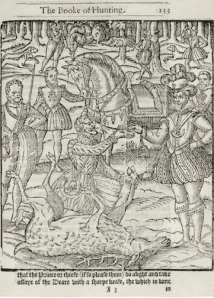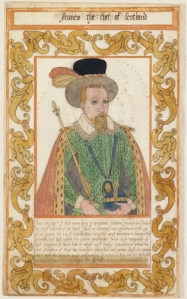Myths Debunked: King James and the King James Bible
OK, more myths to bust. King James I did not translate the King James Bible, and he was also no saint! I’ve seen at least one recent book (a collection of KJV excerpts) entitled King James’s Bible. The implicit claim of this title is true, to the extent that the KJV was commissioned by King James, and it was presumably the Bible he himself used from 1611 until his death in 1625. But, in this last sense, it was pretty much everybody else’s Bible, too.
James certainly did not do any of the translating of the KJV. He was a very scholarly king, interested in theology and the Bible. Among other works, he wrote a book on demonology (1597) and a learned exposition on several chapters of Revelation. He also translated some of the Psalms into meter, but this practice tended to involve turning English prose versions into verse, rather than rendering the original Hebrew into English. Lots of people wrote metrical Psalms at this period, and most didn’t know Hebrew.
James set the KJV ball rolling, but once it was in motion he more or less left it alone. The eminent scholars worked away on the project for years, without any involvement from the monarch. The dedicatory Epistle to King James at the front of the KJV refers to the king as the “principle mover and author of this work.” However, the word “author” in this case doesn’t mean what it does in a phrase like “the author of Shakespeare’s works is William Shakespeare.” It’s closer to our word “authority,” or really someone who authorizes or instigates (as the Oxford English Dictionary puts it).

James I at the hunt (standing, right). Gascoigne, The noble art of venerie or hunting. 1611. Folger.
It’s interesting that the British tend to refer to the KJV as the “Authorized Version,” while Americans prefer the “King James Bible.” The term “Authorized Version” dates from only the nineteenth century, while as early as 1723, according to one writer, it was “commonly called King James’s Bible.” In the seventeenth century, most people just referred to it as the new or latest translation. For the first American edition of the KJV, the “Revolutionary Bible” of 1782, the printer Robert Aitken carefully removed any reference to King James.
I’ve also occasionally heard the KJV described as the “St. James Bible.” Maybe people have the “St. James Infirmary Blues” going through their heads, or they’re thinking of the many churches dedicated to St. James (there are actually several saints by this name, including St. James the Great, St. James the Less, and St. James the Just). I don’t know. But the only James associated with the KJV is King James I, and he was never canonized. Not only was he less than saintly in his behavior (a bit of a party animal), but he was not a Catholic, which seems a fairly basic requirement for sainthood.
We can keep calling it the King James Bible, but we shouldn’t let that nickname mislead us into giving James more credit than he’s due.
Hannibal Hamlin, associate professor of English at The Ohio State University, is co-curator of the Manifold Greatness exhibition at the Folger Shakespeare Library, on view through January 16, 2012.
This entry was posted on December 28, 2011 by Hannibal Hamlin. It was filed under From the Curators, The KJB in History and was tagged with Authorized Version, demonology, King James Bible, King James I, Psalms.






Thanks for the myth busting Dr Hamlin! Important for us to remember that most great things are accomplished by groups not individuals.
December 28, 2011 at 10:00 pm